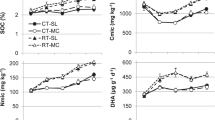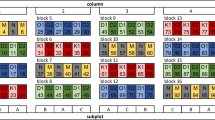Abstract
Soil samples at thirty (30) USDA organic-certified mixed vegetable farms in Michigan, USA were obtained and analyzed for their percentage of soil organic matter (SOM). The intent was to characterize the changes in SOM content, specifically the overall change since organic certification, the patterns of increase or decline, and whether certain agricultural practices are associated with levels of SOM. A short survey of farmers provided supplemental information about each sampling site, including tillage practices, pesticide use, and cover crops. The results indicate a significant majority (24/30) of organic farms showed increases in the percentage of organic matter content, with one farm exhibiting no change and five farms decreasing. These results were achieved in a variety of soil textures, climatic conditions, and over durations from 1–17 years of organic certification. Organic farms had more than twice the percentage of soil organic matter as the ten (10) conventional farms used as a benchmark. In addition, the soil at the sampled organic farms exhibited high positive correlations between SOM and cation exchange capacity, and between pH and cation exchange capacity. Tillage mean depth at those farms increasing their percentages of organic matter was 70% lower than those farms with decreasing percentages of SOM, which suggests low-till or no till practices may help preserve organic matter. In combination with other management methods, such as cover crop usage and soil amendments, a key indicator of soil health was improved and sustained—a primary objective of organic farming.






Similar content being viewed by others
References
Abdollahi L, Munkholm LJ (2014) Tillage system and cover crop effects on soil quality: I. Chemical, mechanical, and biological properties. Soil Sci Soc Am J 78(1):262–270
Bengtsson J, Ahnström J, Weibull AC (2005) The effects of organic agriculture on biodiversity and abundance: a meta-analysis. J Appl Ecol 42(2):261–269
Cardoso EJBN, Vasconcellos RLF, Bini D, Miyauchi MYH, Santos CAD, Alves PRL, Paula AMD, Nakatani AS, Pereira JDM, Nogueira MA (2013) Soil health: looking for suitable indicators. What should be considered to assess the effects of use and management on soil health? Sci Agric 70(4):274–289
Carter MR (1992) Influence of reduced tillage systems on organic matter, microbial biomass, macro-aggregate distribution and structural stability of the surface soil in a humid climate. Soil Tillage Res 23(4):361–372
Chen G, Hooks CR, Lekveishvili M, Wang KH, Pradhan N, Tubene S, Weil RR, Ogutu R (2015) Cover crop and tillage impact on soil quality, greenhouse gas emission, pests, and economics of fields transitioning to organic farming. Final report for project ORG 2011-04944. CRIS Abstracts
Clark MS, Horwath WR, Shennan C, Scow KM (1998) Changes in soil chemical properties resulting from organic and low-input farming practices. Agron J 90(5):662–671
Creamer NG, Dabney SM (2002) Killing cover crops mechanically: review of recent literature and assessment of new research results. Am J Altern Agric 17(1):32–40
De Notaris C, Olesen JE, Sørensen P, Rasmussen J (2020) Input and mineralization of carbon and nitrogen in soil from legume-based cover crops. Nutr Cycl Agroecosyst 116(1):1–18
Doran JW, Zeiss MR (2000) Soil health and sustainability: managing the biotic component of soil quality. Appl Soil Ecol 15(1):3–11
Eichenlaub VL, Harman JR, Nurnberger FV, Stolle HJ (1990) The climatic atlas of Michigan. University of Notre Dame Press
Gerhardt RA (1997) A comparative analysis of the effects of organic and conventional farming systems on soil structure. Biological Agriculture & Horticulture 14(2):139–157
Ghabbour EA, Davies G, Misiewicz T, Alami RA, Askounis EM, Cuozzo NP, Filice AJ, Haskell JM, Moy AK, Roach AC, Shade J (2017) National comparison of the total and sequestered organic matter contents of conventional and organic farm soils. Adv Agronomy 146:1–35
Howard A (1943) An agricultural testament. Oxford University Press, London, UK
Hudson BD (1994) Soil organic matter and available water capacity. J Soil Water Conserv 49:189–194
Jones C, Engel R, Olson-Rutz K (2019) Soil acidification in the semiarid regions of North America’s Great Plains. Crops & Soils 52(2):28–56
Lal R (2016) Soil health and carbon management. Food and Energy Security 5(4):212–222
Loveland P, Webb J (2003) Is there a critical level of organic matter in the agricultural soils of temperate regions: a review. Soil Tillage Res 70(1):1–18
Lucas RE, Holtman JB, Connor JL (1977) Soil carbon dynamics and cropping practices. In: Lockeretz W (ed) Agriculture and energy. Academic Press, New York, pp 333–451
Lupatini M, Korthals GW, de Hollander M, Janssens TK, Kuramae EE (2017) Soil microbiome is more heterogeneous in organic than in conventional farming system. Front Microbiol 7:2064
Magdoff F, Van es H (2009) Building soils for better crops, 3rd edn. Sustainable Agriculture Publications, Waldorf MD
McCauley A, Jones C, Olson-Rutz K (2017) Nutrient management module No. 8. Montana State University USA. Available via: http://landresources.montana.edu/nm/documents/NM8.pdf. Accessed 8 Dec. 2019
McDaniel M (2017) What is soil health, how do we measure it, and why the emphasis on soil biology? Proceedings of the 29th Annual Integrated Crop management Conference. Iowa State University, Ames
Mikha M, Benjamin J, Vigil M, Poss D (2017) Manure and tillage use in remediation of eroded land and impacts on soil chemical properties. PLoS One 12:e0175533. https://doi.org/10.1371/journal.pone.0175533
MOFFA (Michigan Organic Food and Farm Alliance) (2019) https://www.moffa.net/index.html. Accessed 17 November 2019
Nair KP (2019) Soil fertility and nutrient management. In: Soil fertility and nutrient management. In: Intelligent soil management for sustainable agriculture. Springer, Cham, pp 165–189
National Climatic Data Center (2019) Climate of Michigan. https://www.ncdc.noaa.gov/climatenormals/clim60/states/Clim_MI_01.pdf, Accessed 18 November 2019
Neina D (2019) The role of soil pH in plant nutrition and soil remediation. Appl Environ Soil Sci:2019
Novara A, Pulido M, Rodrigo-Comino J, Di Prima S, Smith P, Gristina L, Giminez-Morera A, Terol E, Salesa D, Keesstra S (2019) Long-term organic farming on a citrus plantation results in soil organic matter recovery. Cuadernos de Investigación Geográfica
Oldfield EE, Bradford MA, Wood SA (2019) Global meta-analysis of the relationship between soil organic matter and crop yields. Soil 5(1):15–32
Pimentel D, Hepperly P, Hanson J, Douds D, Seidel R (2005) Environmental, energetic, and economic comparisons of organic and conventional farming systems. BioScience 55(7):573–582
Rabbi SM, Minasny B, McBratney AB, Young IM (2020) Microbial processing of organic matter drives stability and pore geometry of soil aggregates. Geoderma 360:114033
Reganold JP (1988) Comparison of soil properties as influenced by organic and conventional farming systems. Am J Altern Agric 3(4):144–155
Reganold JP, Elliott LF, Unger YL (1987) Long-term effects of organic and conventional farming on soil erosion. Nature 330(6146):370–372
Reicosky DC, Kemper WD, Langdale G, Douglas CL, Rasmussen PE (1995) Soil organic matter changes resulting from tillage and biomass production. J Soil Water Conserv 50(3):253–261
Rodale Institute (2019) Farming system trial. Available via https://rodaleinstitute.org/science/farming-systems-trial/). Accessed 18 November 2019
Salinas-Garcia JR, Hons FM, Matocha JE (1997) Long-term effects of tillage and fertilization on soil organic matter dynamics. Soil Sci Soc Am J 61(1):152–159
Sapkota TB, Mazzoncini M, Bàrberi P, Antichi D, Silvestri N (2012) Fifteen years of no till increase soil organic matter, microbial biomass and arthropod diversity in cover crop-based arable cropping systems. Agron Sustain Dev 32(4):853–863
Sarker TC, Incerti G, Spaccini R, Piccolo A, Mazzoleni S, Bonanomi G (2018) Linking organic matter chemistry with soil aggregate stability: insight from 13C NMR spectroscopy. Soil Biol Biochem 117:175–184
Scholberg JM, Dogliotti S, Leoni C, Cherr CM, Zotarelli L, Rossing WA (2010) Cover crops for sustainable agrosystems in the Americas. In: Lichtfouse E (ed) Genetic engineering, biofertilisation, soil quality and organic farming. Springer, Dordrecht, pp 23–58
Schrama M, De Haan JJ, Kroonen M, Verstegen H, Van der Putten WH (2018) Crop yield gap and stability in organic and conventional farming systems. Agric Ecosyst Environ 256:123–130
Seufert V, Ramankutty N, Foley JA (2012) Comparing the yields of organic and conventional agriculture. Nature 485(7397):229–232
Soil and Water Conservation Society (1995) Farming for a better environment–a white paper Soil and Water Conservation Society: Ankeny Iowa
SPNMSU (Soil Plant and Nutrient Laboratory, Michigan State University) (2019) Sampling instructions. https://www.spnl.msu.edu/Sampling.html. Accessed 24 Nov. 2019
SSSA (Soil Science Society of America) (2019) Soils sustain life. https://www.soils.org/discover-soils/soils-in-the-city/green-infrastructure/building-green-infrastructure/compost. Accessed 1 December 2019
Strickling E (1975) Crop sequences and tillage in efficient crop production. Abstracts of the 1975 Northeast Branch American Society Agronomy Meetings, p. 20–29
Tripathi S, Srivastava P, Devi RS, Bhadouria R (2020) Influence of synthetic fertilizers and pesticides on soil health and soil microbiology. In: Prasad M (ed) Agrochemicals detection. Butterworth-Heinemann, Treatment and Remediation, pp 25–54
USDA (United States Department of Agriculture (2019a) USDA Organic Integrity Database. https://organic.ams.usda.gov/integrity/. Accessed 24 Nov. 2019
USDA (United States Department of Agriculture (2019b) Attachment 1: Guidelines for soil sampling, https://www.nrcs.usda.gov/Internet/FSE_DOCUMENTS/nrcs142p2_031107.pdf. Accessed 24 Nov. 2019
USDA (United States Department of Agriculture (2020) Soil health. https://www.nrcs.usda.gov/wps/portal/nrcs/main/soils/health/. Accessed 6 March 2020
Weil RR (2004) Significance of soil organic matter to soil quality and health. In: Magdoff F, Weil RR (eds) Soil organic matter in sustainable agriculture. CRC Press, Boca Raton, FL, pp 1–43
Weil RR, Brady C (2016) The nature and properties of soils, 15th edn. Pearson, Boston
Williams DM, Blanco-Canqui H, Francis CA, Galusha TD (2017) Organic farming and soil physical properties: an assessment after 40 years. Agron J 109(2):600–609
Williams H, Colombi T, Keller T (2020) The influence of soil management on soil health: an on-farm study in southern Sweden. Geoderma 360:114010
Yang S, Sheng D, Adamowski J, Gong Y, Zhang J, Cao J (2018) Effect of land use change on soil carbon storage over the last 40 years in the Shi Yang River Basin, China. Land 7(1):11
Acknowledgments
The authors would like to thank the farmers who participated in this study. Without their knowledge and hospitality, this study would not have been possible. We would also like to note the professionalism and helpfulness of manager Jon Dahl and staff member Heather Rouse of the Soil and Plant Nutrient Lab at Michigan State University.
Funding
Funding for this study was provided by the Office of Research, University of Michigan-Flint, Research and Creative Activity Fund, grant # U065605.
Author information
Authors and Affiliations
Corresponding author
Additional information
Publisher’s note
Springer Nature remains neutral with regard to jurisdictional claims in published maps and institutional affiliations.
Rights and permissions
About this article
Cite this article
Kaufman, M.M., Steffen, J.M. & Yates, K.L. Sustainability of soil organic matter at organic mixed vegetable farms in Michigan, USA. Org. Agr. 10, 487–496 (2020). https://doi.org/10.1007/s13165-020-00310-6
Received:
Accepted:
Published:
Issue Date:
DOI: https://doi.org/10.1007/s13165-020-00310-6




